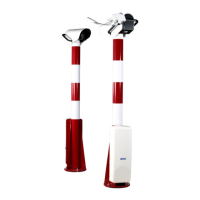Chapter 6 ______________________________________________________________ Maintenance
VAISALA ______________________________________________________________________ 229
To double-check the transmitter location, do the following:
1. Place the ladder behind the receiver and check if the transmitter
light beam (diameter approx. 1.5 m in 30 m distance) must be
further adjusted.
2. Check the edges of the light beam.
If the light is visible even in a distance of approx. 0.5 m below, above,
left, and right from the receiver head, the transmitter is sufficiently
aligned for the following steps.
1. Place the ladder behind the transmitter. The acoustical signal must
be audible.
2. Remove the measurement head cover and check if the receiver
head image is exactly visible through the sight and if the
measurement unit is turned in line with the support unit.
During the following steps, check if the acoustic signal changes to longer
or even permanent signal.
1. If the receiver image in the sight hole is shifted left or right, loosen
the two fastening screws of the support unit (lower two hex-socket
screws, size 4) and turn the support unit slightly until the
orientation is perfect.
2. Tighten the support unit securing screws.
3. Loosen the two securing screws of the transmitter measurement
unit (upper two hex-socket screws, size 4) and turn it carefully in
line with the support unit. Check if you can find a position where
the acoustical signal turns to a longer or even a permanent signal.
4. After optimizing, tighten the measurement unit securing screws.
5. If the receiver image in the sight hole is shifted above or below and
the acoustical signal indicates still a too low signal strength, loosen
the foundation nuts slightly and turn the front nuts to move the base
plate according to your observation.
6. Tighten the foundation nuts carefully after you have finished.
7. Re-install the measurement head cover.
NOTE
In case that the main receiver signal does not exceed 40 % even after
double-checking the raw alignment, proceed with the completion of the
raw alignment followed by the fine alignment as described below.
The completion of the raw alignment by the user has to be confirmed (see
Figure 130 on page 230):
Perform Raw Alignment! Done? (yes/no):

